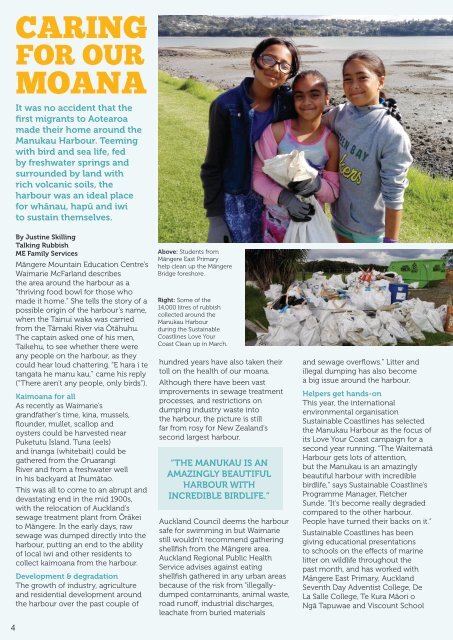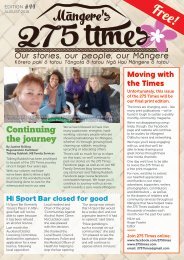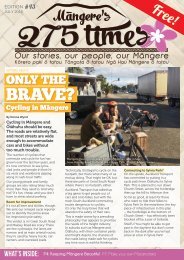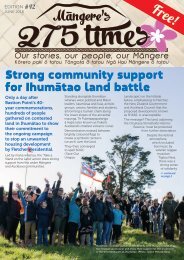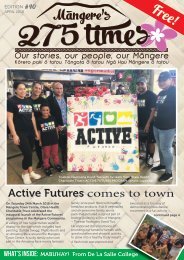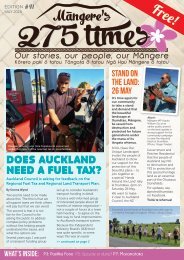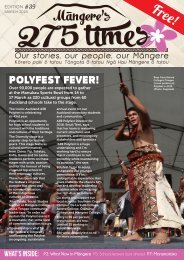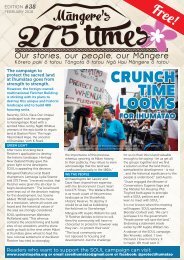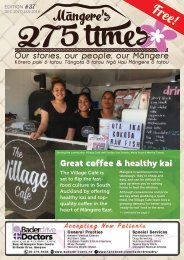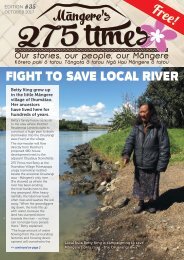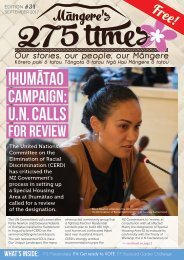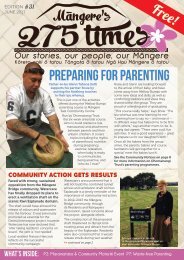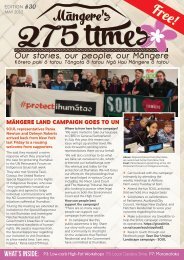275 Times April 2017
Mangere community news - 275 Times
Mangere community news - 275 Times
Create successful ePaper yourself
Turn your PDF publications into a flip-book with our unique Google optimized e-Paper software.
CARING<br />
FOR OUR<br />
MOANA<br />
It was no accident that the<br />
first migrants to Aotearoa<br />
made their home around the<br />
Manukau Harbour. Teeming<br />
with bird and sea life, fed<br />
by freshwater springs and<br />
surrounded by land with<br />
rich volcanic soils, the<br />
harbour was an ideal place<br />
for whānau, hapū and iwi<br />
to sustain themselves.<br />
4<br />
By Justine Skilling<br />
Talking Rubbish<br />
ME Family Services<br />
Māngere Mountain Education Centre’s<br />
Waimarie McFarland describes<br />
the area around the harbour as a<br />
“thriving food bowl for those who<br />
made it home.” She tells the story of a<br />
possible origin of the harbour’s name,<br />
when the Tainui waka was carried<br />
from the Tāmaki River via Ōtāhuhu.<br />
The captain asked one of his men,<br />
Taikehu, to see whether there were<br />
any people on the harbour, as they<br />
could hear loud chattering. “E hara i te<br />
tangata he manu kau,” came his reply<br />
(“There aren’t any people, only birds”).<br />
Kaimoana for all<br />
As recently as Waimarie’s<br />
grandfather’s time, kina, mussels,<br />
flounder, mullet, scallop and<br />
oysters could be harvested near<br />
Puketutu Island. Tuna (eels)<br />
and īnanga (whitebait) could be<br />
gathered from the Oruarangi<br />
River and from a freshwater well<br />
in his backyard at Ihumātao.<br />
This was all to come to an abrupt and<br />
devastating end in the mid 1900s,<br />
with the relocation of Auckland’s<br />
sewage treatment plant from Ōrākei<br />
to Māngere. In the early days, raw<br />
sewage was dumped directly into the<br />
harbour, putting an end to the ability<br />
of local iwi and other residents to<br />
collect kaimoana from the harbour.<br />
Development & degradation<br />
The growth of industry, agriculture<br />
and residential development around<br />
the harbour over the past couple of<br />
Above: Students from<br />
Māngere East Primary<br />
help clean up the Māngere<br />
Bridge foreshore.<br />
Right: Some of the<br />
14,000 litres of rubbish<br />
collected around the<br />
Manukau Harbour<br />
during the Sustainable<br />
Coastlines Love Your<br />
Coast Clean up in March.<br />
hundred years have also taken their<br />
toll on the health of our moana.<br />
Although there have been vast<br />
improvements in sewage treatment<br />
processes, and restrictions on<br />
dumping industry waste into<br />
the harbour, the picture is still<br />
far from rosy for New Zealand’s<br />
second largest harbour.<br />
“THE MANUKAU IS AN<br />
AMAZINGLY BEAUTIFUL<br />
HARBOUR WITH<br />
INCREDIBLE BIRDLIFE.”<br />
Auckland Council deems the harbour<br />
safe for swimming in but Waimarie<br />
still wouldn’t recommend gathering<br />
shellfish from the Māngere area.<br />
Auckland Regional Public Health<br />
Service advises against eating<br />
shellfish gathered in any urban areas<br />
because of the risk from “illegallydumped<br />
contaminants, animal waste,<br />
road runoff, industrial discharges,<br />
leachate from buried materials<br />
and sewage overflows.” Litter and<br />
illegal dumping has also become<br />
a big issue around the harbour.<br />
Helpers get hands-on<br />
This year, the international<br />
environmental organisation<br />
Sustainable Coastlines has selected<br />
the Manukau Harbour as the focus of<br />
its Love Your Coast campaign for a<br />
second year running. “The Waitematā<br />
Harbour gets lots of attention,<br />
but the Manukau is an amazingly<br />
beautiful harbour with incredible<br />
birdlife,” says Sustainable Coastline’s<br />
Programme Manager, Fletcher<br />
Sunde. “It’s become really degraded<br />
compared to the other harbour.<br />
People have turned their backs on it.”<br />
Sustainable Coastlines has been<br />
giving educational presentations<br />
to schools on the effects of marine<br />
litter on wildlife throughout the<br />
past month, and has worked with<br />
Māngere East Primary, Auckland<br />
Seventh Day Adventist College, De<br />
La Salle College, Te Kura Māori o<br />
Ngā Tapuwae and Viscount School


